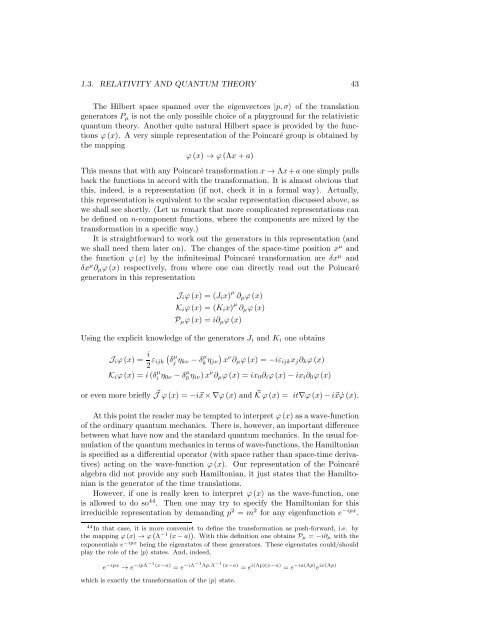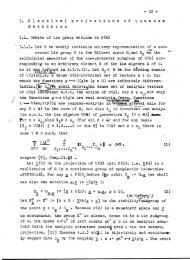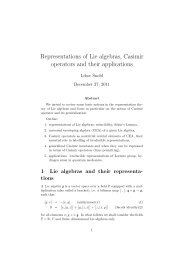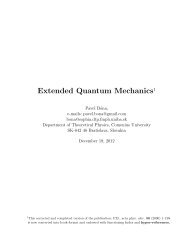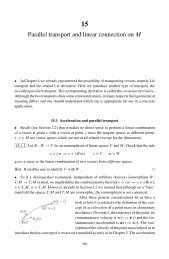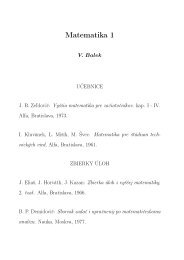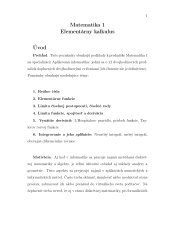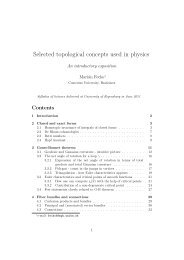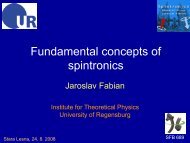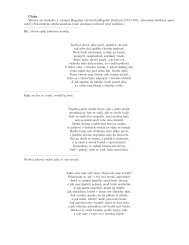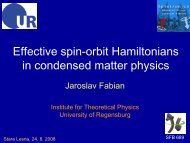Quantum Field Theory I
Quantum Field Theory I
Quantum Field Theory I
You also want an ePaper? Increase the reach of your titles
YUMPU automatically turns print PDFs into web optimized ePapers that Google loves.
1.3. RELATIVITY AND QUANTUM THEORY 43<br />
The Hilbert space spanned over the eigenvectors |p,σ〉 of the translation<br />
generators P µ is not the only possible choice of a playground for the relativistic<br />
quantum theory. Another quite natural Hilbert space is provided by the functions<br />
ϕ(x). A very simple representation of the Poincaré group is obtained by<br />
the mapping<br />
ϕ(x) → ϕ(Λx+a)<br />
This means that with any Poincaré transformation x → Λx+a one simply pulls<br />
back the functions in accord with the transformation. It is almost obvious that<br />
this, indeed, is a representation (if not, check it in a formal way). Actually,<br />
this representation is equivalent to the scalar representation discussed above, as<br />
we shall see shortly. (Let us remark that more complicated representations can<br />
be defined on n-component functions, where the components are mixed by the<br />
transformation in a specific way.)<br />
It is straightforward to work out the generators in this representation (and<br />
we shall need them later on). The changes of the space-time position x µ and<br />
the function ϕ(x) by the infinitesimal Poincaré transformation are δx µ and<br />
δx µ ∂ µ ϕ(x) respectively, from where one can directly read out the Poincaré<br />
generators in this representation<br />
J i ϕ(x) = (J i x) µ ∂ µ ϕ(x)<br />
K i ϕ(x) = (K i x) µ ∂ µ ϕ(x)<br />
P µ ϕ(x) = i∂ µ ϕ(x)<br />
Using the explicit knowledge of the generators J i and K i one obtains<br />
J i ϕ(x) = i 2 ε (<br />
ijk δ<br />
µ<br />
j η kν −δ µ k η jν)<br />
x ν ∂ µ ϕ(x) = −iε ijk x j ∂ k ϕ(x)<br />
K i ϕ(x) = i(δ µ i η 0ν −δ µ 0 η iν)x ν ∂ µ ϕ(x) = ix 0 ∂ i ϕ(x)−ix i ∂ 0 ϕ(x)<br />
or even more briefly ⃗ J ϕ(x) = −i⃗x×∇ϕ(x) and ⃗ Kϕ(x) = it∇ϕ(x)−i⃗x ˙ϕ(x).<br />
Atthispointthereadermaybetempted tointerpretϕ(x) asawave-function<br />
of the ordinary quantum mechanics. There is, however, an important difference<br />
between what have now and the standard quantum mechanics. In the usual formulation<br />
ofthe quantum mechanicsin termsofwave-functions, the Hamiltonian<br />
is specified as a differential operator (with space rather than space-time derivatives)<br />
acting on the wave-function ϕ(x). Our representation of the Poincaré<br />
algebra did not provide any such Hamiltonian, it just states that the Hamiltonian<br />
is the generator of the time translations.<br />
However, if one is really keen to interpret ϕ(x) as the wave-function, one<br />
is allowed to do so 44 . Then one may try to specify the Hamiltonian for this<br />
irreducible representation by demanding p 2 = m 2 for any eigenfunction e −ipx .<br />
44 In that case, it is more conveniet to define the transformation as push-forward, i.e. by<br />
the mapping ϕ(x) → ϕ ( Λ −1 (x−a) ) . With this definition one obtains P µ = −i∂ µ with the<br />
exponentials e −ipx being the eigenstates of these generators. These eigenstates could/should<br />
play the role of the |p〉 states. And, indeed,<br />
e −ipx → e −ipΛ−1 (x−a) = e −iΛ−1 Λp.Λ −1 (x−a) = e i(Λp)(x−a) = e −ia(Λp) e ix(Λp)<br />
which is exactly the transformation of the |p〉 state.


